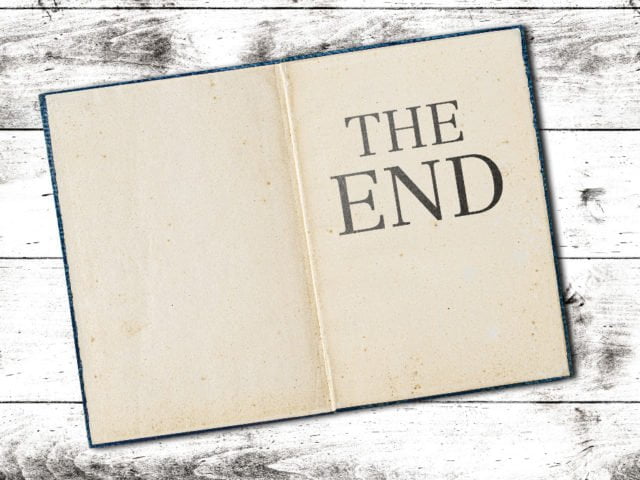The word ‘dénouement’ is a borrowed word that came to the English language via the French word denoue. Its literal Latin meaning is to ‘untie the knot’. This is why we now use it as a literary term to refer to the conclusion of a novel.
In this article, I will explain the definition and purpose of literature dénouement, demonstrate how to confidently use dénouement to improve your storytelling and story structure, as well as illustrate examples of dénouement in well-known stories.
What Is A Dénouement In Literature?
The dénouement of a story (whether it’s a book, play or movie) is a literary device that involves the tying up of all the loose ends, the ironing out of the plot, and the final resolution that should leave your audience feeling satisfied.
As writers, the narrative of our work should have a story arc and take readers through the five stages of development; exposition, rising action, climax, falling action, and dénouement.
Dénouement occurs at the very end and it needs to help readers understand the bigger picture and how all of the subplots and events have led to its creation. This is true for all genres and forms of storytelling.
But why can’t we simply leave our readers guessing, instead of finishing on a high note? Let’s find out…
What Is The Purpose Of Dénouement In Literature?
Simply put, stories demand conflict. Conflict, in turn, leads to a climax which then demands dénouement in the final scene to give the audience a sense of closure. You can’t get to the exciting point then leave readers guessing!
It is also the part where we discover the moral of a story, or we learn the lesson. Human beings love to see good beat evil. This is why dénouement is particularly important when it comes to children’s books (where everyone ‘lived happily ever after’).
Of course, this doesn’t mean every single novel has to have a fully-formed dénouement in its final pages. If the book is part of a series, the final chapter may wrap up the book’s side storyline, but there may be a cliffhanger for the bigger story thread in order to entice readers to the next book.
Although some standalone books break the writing rules and shun dénouement completely.
The critically acclaimed Tangerine by Christine Mangan is testament to that. Whilst in the film world, Jordan Belfort remains an unsavoury idol in the award-winning The Wolf of Wall Street. Not all stories can have the typical Happily Ever After (we will see more examples of that later on), but authors should strive to offer, if not a conclusive finale, at least a glimmer of hope!

Is An Epilogue The Same As Dénouement?
It’s tempting to think that epilogue is just another word for dénouement. It’s not.
An epilogue is an optional section that a writer may choose to add to their story – or not – to show how characters are faring after the main storyline has finished (think of the Harry Potter series when we see the kids as adults at the very end).
Therefore, the criteria of an epilogue doesn’t extend itself to restoring immediate order and giving readers a sense of finality – it’s simply an add-on, an optional glimpse into the future.
Examples Of Dénouement In Literature
Let’s take a look at some dénouement examples in action (beware, spoilers abound!):
Romeo And Juliet (William Shakespeare)
William Shakespeare’s Romeo and Juliet highlights the importance and impact of employing dénouement as a technique for closure.
Instead of offering a happy ending, the double suicide of the main characters means this particular dénouement teachers the audience a lesson – that it was their death, not their love, that healed the family feud.
William Shakespeare was a master of dénouement, ensuring that every last scene in his plays culminated in a dramatic (and conclusive) finale!
Like Water For Chocolate (Laura Esquivel)
Like Water For Chocolate’s finale offers readers a hugely rewarding dénouement.
Firstly, Tita’s efforts are a literal breakthrough for the next generation in her family. The battle for her niece pays off and Esperanza can now marry whoever she chooses without being duty-bound to care for her mother – just as Tita had to for so many precious years of her life.
However, Rosaura’s death also creates a new beginning for Tita herself. Now that Pedro is a widower, finally they no longer need to hide their love for one another and they can be together.
The Queen’s Gambit (Walter Tevis)
The popular Netflix series (and book adaptation) could not have left us with a greater celebration of accomplishment on behalf of its genius chess-playing protagonist.
Beth’s life challenges up until the point of dénouement have been enormous. But despite everything her life has thrown at her, she overcomes every one of her hurdles to finally defeat her greatest chess rival, bringing her story to a highly satisfying conclusion.

Other Literary Work With Satisfactory Dénouement
Moby Dick (Herman Melville)
The sea rolled in and everyone died… except our narrator, Ishmael. Killing everyone off is one way to finish a story, worked for Shakespeare too!
The Great Gatsby (Scott Fitzgerald)
After the climax of Myrtle’s accidental death, leading to Gatsby’s murder, the narrator (Nick Carraway) decides to leave Long Island high society and return to the Midwest.
The Catcher In The Rye (J. D. Salinger)
In the final scene, Holden Caulfield calmly watches Phoebe riding a carousel, a sweet childhood moment of innocence, and Holden resolves to worry less about adulthood and the future.
How To Use Dénouement In Your Story
We all have unique storytelling voices and naturally this extends to the manner in which we deliver our dénouement. There’s the light dénouement (yay, everyone survives and is happy) and the dark dénouement (oh, they all die).
The best way to learn about what endings work best is to read books and watch movies as much as possible, in all genres, and look out for each example of a dénouement. Ask yourself why certain endings fill you with the feel-good factor and leave you satisfied… and why others don’t.
Some stories don’t suit a happy ending, and that’s fine; it’s important your dénouement makes sense in the context of the whole story.
Here Are Five Basic Rules To Follow:
- Dénouement should tie up every single loose end in such a way that a quick tug won’t make everything unravel again! Readers should not be left with a single niggle.
- Dénouement should allow key characters the chance to reflect realistically on their story, whilst taking into account whether their reactions feel warranted.
- Dénouement should be plausible and believable (even if you write fantasy, the book should be wrapped up in a way that makes sense).
- Dénouement should complete the aforementioned story arc and work in harmony with the previous components of it: exposition, rising action, climax, and falling action.
- Dénouement should link effortlessly with the main themes of your novel.

Frequently Asked Questions
What Is The Difference Between Resolution And Dénouement?
These two literary terms may seem interchangeable at first but they are significantly different. A resolution can happen at any time in the story, and will typically play out in the form of a character solving a major problem. A dénouement, on the other hand, is what takes place at the end of a story and answers all remaining questions the reader may have.
What Is Included In The Dénouement?
The dénouement of a story is at the author’s discretion, but it is definitely the point at which the bad guys should be revealed (and hopefully brought to justice), the hero rewarded, secrets unearthed, and loose ends tied up. Writers take readers on a journey of escapism, so that journey needs to have a satisfyingly plausible ending.
How Long Is A Dénouement?
As the last structural element of a novel, the dénouement should wrap everything up as quickly and neatly as possible in one or two scenes. That said, it will depend on how many characters and subplots require disentanglement. One way to work around this is to try not to leave too many loose ends until those last few pages.
How Do You Write A Dénouement?
When it comes to writing a book, plotting the dénouement is always a smart move (even if you prefer to make it up as you go along). Leave your readers happy or shocked, but a vague fade to black will not cut it!
Refer back to the key points made in this article and make sure you have added each element to your manuscript. Some writers like to work backwards, starting with the ending then ensuring they add all the foreshadowing and hints that will make the last scene (and possibly big twist) plausible and satisfying.
The End
I hope this article has given you a conclusive summary of what to do in the final part of your story.
It may be tempting to cut corners when you’re on the verge of typing THE END, but it’s vital to be just as diligent with your dénouement as you are with your opening chapter.
Because your final words, and that final scene, will stay with your readers forever.
Jericho Writers is a global membership group for writers, providing everything you need to get published. Keep up with our news, membership offers, and updates by signing up to our newsletter. For more writing articles, take a look at our blog page.










